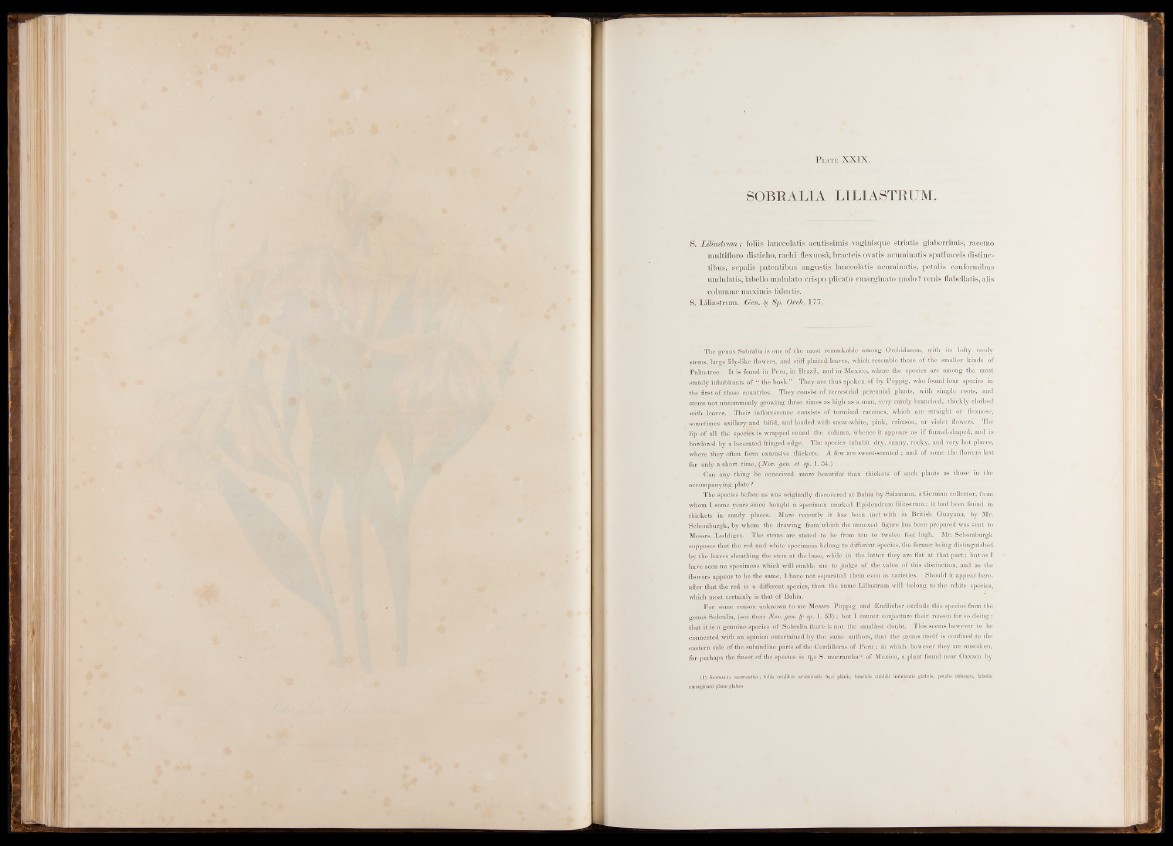
SOBRALIA LILIASTRUM.
S. Liliostrum; foliis lanceolatis acutissim is vaginisque striatis glaberrimis, racemo
m ultifloro disticho, rachi flexuosa, bracteis ovatis acum inatis spathaceis distinc-
tibus, sepalis patentibus angustis lanceolatis acum inatis, petalis conformibus
undulatis, labello undulato crispo plicato emarginato nudo ? venis flabellatis, alis
columnse m axim is falcatis.
S. Liliastrum . Gen. § Sp. Orch. 177.
The genus Sobralia is one of the most remarkable among Orchidace®, with its lofty reedy
stems, large lily-like flowers, and stiff plaited leaves, which resemble those of the smaller kinds of
Palm-tree. It is found in Peru, in Brazil, and in Mexico, where the species are among the most
stately inhabitants of “ the bush.” They are thus spoken of by Poppig, who found four species in
the first of these countries. They consist of terrestrial perennial plants, with simple; roots, and
stems not uncommonly growing three times as high as a man, very rarely branched, thickly clothed
with leaves. Their inflorescence consists of terminal racemes, which are straight' or flexuose,
sometimes axillary and bifid, and loaded with snow-white, pink, crimson, or violet flowers. The
lip of all the species is wrapped round the column, whence it appears as if funnel-shaped, and is
bordered by a lacerated fringed edge. The species inhabit dry, sonny, rocky, and very hot places,
where they often form extensive thickets. A few are sweet-scented; and of some the flowers last
for only a short time, {Nov. gen. et sp. 1. 54.)
Can any thing be conceived more beautiful than thickets of such plants as those in the
accompanying plate ?
The species before us was originally discovered at- Bahia by Salzmann, a German collector, from
whom I some years since bought a specimen marked Epidendrum liliastrum; it had been found in
thickets in sandy places. More recently it has been met with in British Guayana, by Mr.
Schomburgk, by whom the drawing from which thé annexed figure has been prepared was sent to
Messrs. Loddiges. The stems are stated to be from ten to twelve feet high. Mr. Schomburgk
supposes that the red and white specimens belong to different species, the former being distinguished
by the leaves sheathing the stem at the base, while in the latter they are flat at that part; but as I
have seen no specimens which will enable me to judge of the value of this distinction, and as the
flowers appear to be the same, I have not separated them even as varieties. Should it appear hereafter
that the red is a different species, then the name Liliastrum will belong to the white species,
which most certainly is that of Bahia.
For some reason unknown to me Messrs. Poppig and Endlicher exclude this species from the
genus Sobralia, (see their Nov. gen. 8f sp. 1. 53); but I cannot conjecture their reason for so doing ;
that it is a genuine species of Sobralia there is not the smallest doubt. This seems however to be
connected with an opinion entertained by the same authors, that the genus itself is confined to the
eastern side of the subandine parts of the Cordilleras of Peru ; in which however they are mistaken,
for perhaps the finest of the species is %e S. macranthafl) of Mexico, a plant found near Oaxaca by 1
(1) Sobralia macranthafoliis ovalibus acuminatis basi plains, bracteis strobili imbricatis glabris, petalis oblongis, labello